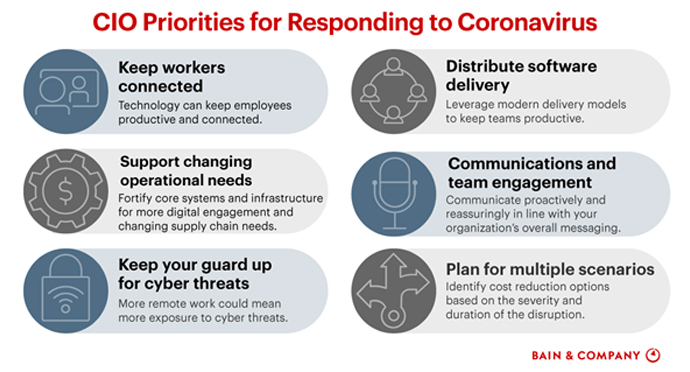The Evolving Role of CIOs in Times of Covid-19

CIOs Challenges in 2020
The scale and impact of the COVID-19 pandemic has been humongous with the contagion unleashing unprecedented chaos, disruptions and economic disturbances across the globe. With an overnight rise in demand for digital solutions and robust IT infrastructures, organizations around the world are looking for innovative and prescient solutions to ensure they survive through this mess by adroitly adapting to the changing times.
The challenges faced by CIOs in 2020 are huge, which means they have an incredibly critical role to play in times of Covid-19 as organizations look towards them to digitize processes and operations and ensure the organization can function normally in these extremely trying times.
CIO’s Dilemma
CIOs of today have to confront a perilous situation, as they are burdened with the incredibly tough task of seamlessly managing ambitious transformational business objectives with very limited resources at their disposal.
As a Digital Transformation enabler, the role of a CIO in an organization is crucial with regards to arranging myriads of digitization projects methodically to make sure the business operations continue uninterrupted while at the same time ensuring the business’s structure and integrity is maintained.
“Successful CIOs have become business leaders of digital business units or have empowered IT to create a digital backbone” says Steve Hall, partner and president at technology research and advisory firm ISG (Source: The Enterprisers Project)
In current Covid-19 times, the modern CIO needs to ensure business can work remotely and flexibly, and the employees can confidently carry out their responsibilities from remote locations, without compromising IT security and data confidentiality. Source: Bain & Company
The challenges thrown by the pandemic and equally adept response by CIOs who have spectacularly risen to the occasion has greatly enhanced their organizational credibility.
However, according to Gartner, Inc, few complex challenges still remain and the CIOs have to deal with them with equal finesse and tact to sustain their high status.
A Gartner CIO Research Circle (a Gartner managed panel) survey of 58 CIOs in May 2020 revealed that 43% of respondents had already started to put in motion post-COVID-19 strategies for their organizations, while 38% were in their initial stages of devising strategies to deal with a post-Covid world. (Source: Gartner)
“CIOs, in many organizations, were instrumental in dealing with the initial impact of COVID-19 on organization. Enterprises continue to operate with a heavy lift from IT organizations, especially in enabling a newly dispersed workforce to work from home. Consequently, many CIOs have a new opportunity to take a seat at the table when senior leaders decide enterprise strategy and which lines of business to ramp up and which ones to reduce,” said Andy Rowsell-Jones, distinguished research vice president at Gartner. (Source: Gartner)
A very important aspect of the research has been that it has established the fact that the crisis and its successful handling by CIOs have greatly improved their relationships with business leaders. The benefit of this interaction flows both ways with three-fourth of the respondents saying they educated CEOs and other senior leaders during the crisis, while two-thirds of CIOs said they added to their limited knowledge of business operations.
How The Role of CIO Has Undergone Transformation During the Pandemic
Adjust To the New Normal
The first and foremost priority of a CIO in these uncertain times is to quickly adapt to new technological practices that will allow seamless virtual employee collaboration. The CIO’s office needs to prioritize those tools that will allow secure sharing of data and ensure that employees are confident in being able to do so.
The office of the CIO will need to ensure scaling up of VPN concentrators, portals, customer-facing applications and gateways along with digital process infrastructure to efficiently cope up with the added workload that’s bound to come up with a large number of employees who will need to work remotely and maintain online connection.
They should also be scalable to adapt to the increasing volume of business going digital. The CIO’s team needs to keep a close watch on infrastructure’s performance and make suitable alterations to ease the load and nip any disruptions.
Business Continuity & Employee Safety
With easing lockdown restrictions and resumption of economic activities, CIOs need to concern themselves with the health and safety of the organization’s employees. Lockdown ease and businesses start ramping up; the CIO’s priority is shifting towards employee health and safety in the workplace. Adequate safety measures should be put in place to ensure the employees returning to work do not feel threatened by the pandemic.
Collective health management needs to be prioritized to prevent the possibility of a COVID-19 outbreak within the organization. IT has a very critical role to play here as they need to take care of employees’ attendance and work schedule to ensure sufficient social distancing is maintained.
Additionally, they need to invest more in data analytics and AI to predict the likelihood and conditions that may cause the virus to spread.
The CIO, along with the company’s management, will have to invest money, time and resources to adequately train their employees to cope up with the new ways of working.
Workflow Digitization
The migration towards the latest technologies is not going to be fully sufficient in itself. The CIO will have to devise methods of aligning the technology with current processes at least till a vaccine is developed.
The CIO will have to rearrange internal processes to implement measures such as touch-free attendance, digital signature and online validations to name a few, to ensure that there is no security breach.
Additional Load On Cloud-based Services
Working remotely is definitely going to place additional load on cloud-based services. The CIO needs to assess if the organization possesses adequate scaling capabilities to pump up the computational power for disruption-free working.
Scaling up of resources owing to heightened demand for cloud computing services also will place additional stress on resources.
The CIO needs to closely monitor the requirement for extra services and make necessary arrangements in a time bound manner.
The CIO CISO Relationship
CISOs, who now have assumed the role of “Digital Security Warriors” with the rise in phishing attacks since the beginning of the pandemic, and with employees working from home the vulnerability has increased more than ever.
According to Mark Ward, senior research analyst at ISF, the next-generation CISO is becoming less about tech and more about talking. “CISOs are used to having their hands on the keyboard, but they need to step away from that and get out and about, meet people and solve their problems,” he said. “It’s becoming a real diplomatic posting—partly because infosec as a discipline crosses the boundaries of so many other departments.” (Source: Security Magazine)
The pandemic has also made CIOs relook at their IT priorities and continuing digital transformation initiatives and as always IT employees playing a key role in achieving them. A digitally connected workplace has become a reality more than ever.
With teams adapting to remote work, it becomes essential for the office of the CIO to have “break glass” procedures in place to minimize dependency and ensure that employees are provided access to mission critical systems without the threat of data security and network management being compromised.
The relationship between CIOs and CISOs needs to strengthen and they should work collaboratively to solve problems and meet business goals in these times.
Great emphasis needs to be laid on the security with plans of who will take charge and call the shots if the chief security officer is absent.
Enforcing Technological Changes and Implementation from The Boardroom
We live in a data-driven world which means the days of the CIO remaining invisible behind the curtains are passe. The CIO’s position within the company will swing from that of a tech-driven role to more that of a strategic digital business transformation enabler for the organization.
Responsible for overseeing and implementing the entire gamut of activities related to business technology, the CIOs need to seamlessly align IT with strategic business goals. The CIO’s role takes a gigantic leap as the person is required to work closely with the CEO to provide the right guidance to help businesses successfully navigate the pandemonium created by the pandemic.
Conclusion
The onset of the COVID-19 crisis has made us dependent on technology more than ever. With the pandemic completely reshaping how we work and live, and changing landscape of businesses, the role of a CIO today has undergone a complete transformation and as technology trends change, the CIOs role would evolve more in the coming years.
Increased reliance of businesses on technology means there need to be closer collaboration between IT and the rest of the business. This means the role of a CIO in an organization is evolving to be a strategic partner who can provide a unique view into what’s been going on and help enterprises switch course to prosper in the current uncertain environment.


